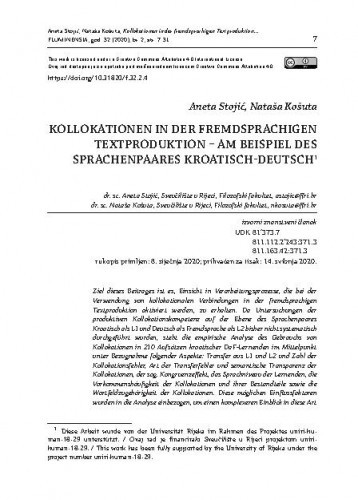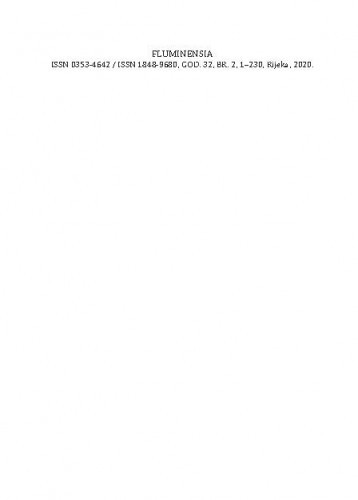Ziel dieses Beitrages ist es, Einsicht in Verarbeitungsprozesse, die bei der Verwendung von kollokationalen Verbindungen in der fremdsprachigen Textproduktion aktiviert werden, zu erhalten. Da Untersuchungen der produktiven Kollokationskompetenz auf der Ebene des Sprachenpaares Kroatisch als L1 und Deutsch als Fremdsprache als L2 bisher nicht systematisch durchgeführt wurden, steht die empirische Analyse des Gebrauchs von Kollokationen in 210 Aufsätzen kroatischer DaF-Lernenden im Mittelpunkt unter Bezugnahme folgender Aspekte: Transfer aus L1 und L2 und Zahl der Kollokationsfehler, Art der Transferfehler und semantische Transparenz der Kollokationen, der sog. Kongruenzeffekt, das Sprachniveau der Lernenden, die Vorkommenshäufigkeit der Kollokationen und ihrer Bestandteile sowie die Wortfeldzugehörigkeit der Kollokationen. Diese möglichen Einflussfaktoren wurden in die Analyse einbezogen, um einen komplexeren Einblick in diese Art lexikalischer Kompetenz zu gewinnen, was zu einem besseren Verständnis dieser Problematik führt und somit die Grundlage für praktische Implikationen bietet. Wie die Untersuchungsergebnisse zeigen, überwiegt im analysierten Korpus der normgerechte Gebrauch von denjenigen Kollokationen, die in L1 und L2 übereinstimmen und semantisch transparent sind, während Abweichungen bei divergenten Strukturen zu vermerken sind. Ebenfalls ergeht aus den Ergebnissen, dass mit dem Steigen der Fremdsprachenkompetenz zwar ein wesentlicher Unterschied in der Zahl, nicht jedoch in der Fehlerqoute der verwendeten Kollokationen zu vermerken ist. Dies bestätigt die Notwendigkeit der Förderung der Kollokationskompetenz als integrativem Teil der lexikalischen Kompetenz, wobei der gezielten Schulung von divergierenden Strukturen auf der Ebene eines bestimmten Sprachenpaares im Fremdsprachenunterricht mehr Aufmerksamkeit geschenkt werden sollte.; The aim of this paper is to gain an insight into the mechanisms activated in L2 production, with a special focus on the use of collocations in the written text production in L2 German. In order to achieve the aim, an empirical analysis of the use of collocations was carried out on the corpus of 210 compositions written by Croatian learners of German, in accordance with the following aspects: L1 to L2 transfer and the number of errors in collocational concordance, the type of transfer and semantic transparency of collocations, the so called congruency effect, the level of proficiency in German, the frequency of occurrence of a certain collocation and its constituents, and the semantic field of a certain collocation. The inclusion of these aspects into the analysis enables the gaining of a more complex insight into collocational competence as an integrative part of lexical competence, which in turn contributes to a better understanding of collocational issues and creates a basis for practical implications. The results of the research show that in the analyzed corpus the use of collocations in accordance with the standard German language prevails in those collocations that are congruent in L1 and L2 and, at the same time, semantically transparent; the deviations from the standard are seen in incongruent structures. The results also show that with increased proficiency in L2 the use of collocations increases, but the number of errors, that is, deviations from the standard, does not decrease. This points to the need for developing collocational competence in foreign language teaching, where special attention needs to be given to the acquisition of structures incongruent at the level of L1 and L2.; Cilj je ovoga rada steći uvid u mehanizme koji se aktiviraju u procesu proizvodnje na stranome jeziku s osobitim obzirom na uporabu kolokacija u pisanoj proizvodnji teksta na njemačkome kao stranome jeziku. Kako bi se ostvario cilj provedena je empirijska analiza uporabe kolokacija na korpusu od 210 sastavaka hrvatskih učenika njemačkoga jezika, a prema sljedećim aspektima: prijenos iz materinskoga i stranoga jezika i broj pogrešaka u kolokacijskome slaganju, vrsta prijenosa i semantička transparentnost kolokacija, tzv. efekt podudarnosti, stupanj ovladanosti njemačkim jezikom, učestalost pojavljivanja određene kolokacije i njezinih sastavnica te pripadnost kolokacije određenome semantičkom polju. Uključivanje navedenih aspekata u analizu omogućuje stjecanje kompleksnijega uvida u kolokacijsku kompetenciju kao integrativnoga dijela leksičke kompetencije, što doprinosi boljemu razumijevanju kolokacijske problematike te ujedno stvara temelj za praktične implikacije. Rezultati provedenoga istraživanja pokazuju kako u analiziranome korpusu prevladava uporaba u skladu s normom standardnoga njemačkog jezika kod onih kolokacija koje su u L1 i L2 podudarne i ujedno semantički transparentne, dok su odstupanja od norme primjetna kod divergentnih struktura. Iz rezultata također proizlazi kako s rastućom kompetencijom u stranome jeziku raste samo broj uporabljenih kolokacija, dok se broj pogrešaka tj. odstupanja od norme ne smanjuje. To govori u prilog potrebi razvijanja kolokacijske kompetencije u nastavi stranoga jezika, pri čemu posebnu pažnju valja posvetiti ovladavanju divergentnim strukturama na razini materinskoga i određenoga stranog jezika.
Sažetak

 Fluminensia : časopis za filološka istraživanja : 32,2(2020) / glavni i odgovorni urednik Aleksandar Mijatović.
Fluminensia : časopis za filološka istraživanja : 32,2(2020) / glavni i odgovorni urednik Aleksandar Mijatović.